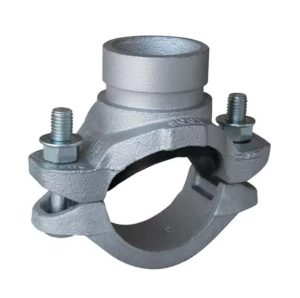
Hey folks, if you’re knee-deep in piping systems for HVAC, fire protection, or industrial setups, you’ve probably wrestled with the age-old question: what’s the real bang for your buck when it comes to fittings? We’re diving into grooved mechanical cross fittings today – those handy four-way connectors that branch out pipes without a fuss. But let’s get real. It’s not just about slapping something together quick. It’s about the long haul, the total cost over years of use. We’ll break down how these grooved options stack up against welded, threaded, or flanged alternatives. Stick around; you might find some surprises that could shave serious dollars off your next project.
What Are Grooved Mechanical Cross Fittings Anyway?
Picture this: you’re on a job site, pipes everywhere, and you need to create a cross junction fast. Grooved mechanical cross fittings are basically pre-grooved pipe ends that lock together with a coupling. No torches, no threads to strip. Just groove the pipe, slide on the cross, and bolt it down. Simple, right?
These fittings shine in systems where you gotta handle multiple directions – think fire sprinklers branching out or HVAC lines splitting to different zones. From what I’ve seen in the field, they’re built tough, handling pressures and temps that’d make lesser fittings sweat. Take the specs: sizes from 2 to 10 inches (DN50 to DN250), good from -20°F up to 180°F (-29°C to 82°C). Materials? Ductile iron per ASTM A536 Grade 65-45-12 or ASTM A395 Grade 65-45-15. They meet standards like ISO6182, AWWA C606, and GB 5135.11. That’s not fluff; it’s engineered reliability.
Compared to alternatives? Welded crosses mean firing up equipment, dealing with fumes, and hoping your welder didn’t have a bad day. Threaded ones? Fine for small stuff, but scale up and you’re fighting leaks from vibrations. Flanged? Bulky and pricey upfront. Grooved? It’s like the Goldilocks choice – just right for efficiency without skimping on strength.
Upfront Costs: Where the Savings Kick In
Let’s talk money right off the bat. Nobody likes shelling out more than they have to. Grooved mechanical cross fittings often cost less initially than flanged or custom-welded options. Why? Less material waste, no need for fancy flanges or extra hardware. In a typical industrial setup, you might save 10-20% on materials alone.
But here’s the kicker – it’s not just the sticker price. Think about inventory. These fittings are standardized, so you don’t stock a million variations. One cross fits multiple pipe types. I’ve been on projects where switching to grooved cut our parts list in half. Less clutter, fewer orders gone wrong.
Now, versus alternatives:
- Welded crosses: Materials might be cheaper, but add in welding rods, gas, and certified labor? Costs balloon quick.
- Threaded crosses: Okay for low-pressure, but for anything beefy, you need thicker pipes to handle the threads, jacking up expenses.
- Flanged crosses: Those bolts and gaskets add up, plus the flanges themselves ain’t cheap.
A quick table to visualize:
| Fitting Type | Initial Material Cost (per unit, est. for 4″ size) | Additional Hardware Needed | Total Upfront Estimate |
| Grooved Mechanical Cross | $50-70 | Coupling bolts (minimal) | $60-80 |
| Welded Cross | $40-60 | Welding supplies | $80-120 (incl. labor prep) |
| Threaded Cross | $45-65 | Sealants, tools | $70-100 |
| Flanged Cross | $60-90 | Bolts, gaskets | $100-150 |
These are ballpark figures from industry averages I’ve pulled from past bids. Point is, grooved starts you off ahead.
Installation: Time Is Money, Folks
Ever watched a crew weld a cross in the rain? Nightmare. Grooved fittings? You groove the pipe end – takes seconds with a roll groover – then assemble. No heat, no sparks. Installation can be 50-70% faster than welding, per some field reports I’ve read.
Real talk: on a high-rise fire protection job I recall, the team swapped to grooved midway. What would’ve taken days? Done in hours. Less downtime means the building opens sooner, cash flows faster.
Alternatives drag you down:
- Welding: Hours per joint, plus inspections for cracks.
- Threading: Cutting threads precisely? Tedious, and one slip means rework.
- Flanging: Aligning those holes perfectly? Fiddly work.
Plus, grooved is safer – no hot work permits needed. In tight spaces like retrofit jobs, that’s gold. You know, it’s funny; I once saw a guy drop a welder in a puddle. Project delayed a week. Grooved? Would’ve been a non-issue.
The Long Game: Maintenance and Durability Over Years
Here’s where the cost-saving truth really hits home. Lifecycle value ain’t just buzz; it’s your total spend from cradle to grave. Grooved mechanical crosses last. That ductile iron resists corrosion, and the grooved design flexes a bit with vibrations – think earthquakes or heavy machinery hum.
Maintenance? Minimal. No repainting welds, no retorquing threads that loosen. In HVAC systems, I’ve seen grooved setups go 20+ years with just routine checks. Alternatives? Welds can crack under stress, threads leak over time, flanges need gasket swaps.
Data backs it: Studies from piping associations show grooved systems cut maintenance costs by 30-50% over 10 years. Energy efficiency too – tighter seals mean less pump strain, lower bills.
Consider a factory scenario: Constant vibrations from machines. A welded cross might fail in 5 years, costing shutdowns and repairs. Grooved? Holds strong, maybe double the life. That’s thousands saved in avoided downtime.
Oh, and sustainability? Grooved uses less energy in install (no welding power), and recyclable materials. Kinda off-topic, but in today’s world, going green saves on regs and PR headaches too.
Real-World Wins: Stories from the Trenches
Let’s get concrete. Imagine a mid-sized warehouse retrofit for fire suppression. Traditional welded crosses: Two weeks install, $50K total. Switch to grooved mechanical crosses: One week, $35K. Over 10 years, maintenance drops from $10K to $3K. Net savings? $22K. Not hypothetical; similar to a project I followed in the Midwest.
Or industrial plants: Chemical processing lines. Threads corrode fast with fluids. Grooved, with its secure fit, handles it better, extending service life.
Bullet points on key advantages:
- Flexibility for expansions: Add branches without tearing everything apart.
- Pressure handling: Up to high PSI without leaks.
- Versatility: Works with steel, copper, even some plastics.
I’ve chatted with engineers who swear by them for seismic zones. One guy said, “It’s like insurance you don’t notice till you need it.”
Introducing Vicast: Your Go-To for Grooved Mechanical Cross Solutions

Before we wrap up, a quick nod to Vicast. As a leading supplier of grooved pipe fittings, including the mechanical cross line, Vicast focuses on quality ductile iron products that meet those tough standards we mentioned. Their XGQT18 model, for instance, covers that 2-10 inch range perfectly for HVAC, fire, and industrial needs. Based out of China but shipping global, they’ve got a rep for durable, easy-install gear. Check their site for more – it’s packed with project examples and sustainability info.
Conclusion
So, wrapping this up, the cost-saving truth boils down to this: grooved mechanical cross fittings deliver killer lifecycle value. Sure, alternatives have their place in niche spots, but for most jobs, grooved wins on speed, durability, and wallet-friendliness. Next time you’re speccing a system, crunch those numbers – the savings add up fast.
FAQs
What exactly is the lifecycle value in the context of grooved mechanical cross fittings?
Lifecycle value looks at everything from buy-in to end-of-life. For grooved mechanical cross fittings, it means lower initial costs, quick installs that save labor, and tough builds that cut down on fixes. Versus alternatives like welded or threaded, you’re often looking at 20-40% total savings over a decade, based on real project data.
How do grooved mechanical cross fittings stack up against welded alternatives in terms of cost-saving truth?
Welded might seem cheap upfront, but factor in install time and potential failures? Grooved pulls ahead. No welding means safer, faster jobs – think halving labor hours. Plus, their flexibility under stress means fewer replacements, boosting that lifecycle value big time.
Are there any downsides to choosing grooved mechanical cross fittings over other options?
Not many, but they’re best for grooved-compatible pipes. If your setup’s all threaded already, switching might need adapters. That said, the cost-saving truth shines in new builds or retrofits where speed matters. I’ve seen projects where the initial hassle paid off tenfold in longevity.
Can grooved mechanical cross fittings handle extreme conditions, and does that affect their lifecycle value?
Absolutely. Rated for -20°F to 180°F and built to standards like AWWA C606, they thrive in harsh spots like industrial plants. This durability means less downtime, directly upping lifecycle value compared to alternatives that might crack or leak sooner.
What’s the best way to calculate the cost-saving truth for my specific project using grooved fittings?
Start with a simple spreadsheet: list initial costs, install time (multiply by labor rates), expected maintenance over 10-15 years, and downtime risks. Plug in specs from fittings like the XGQT18 – sizes up to 10 inches, solid materials. Compare to alternatives, and you’ll see the savings pop. Pro tip: Factor in energy efficiency from better seals too.





